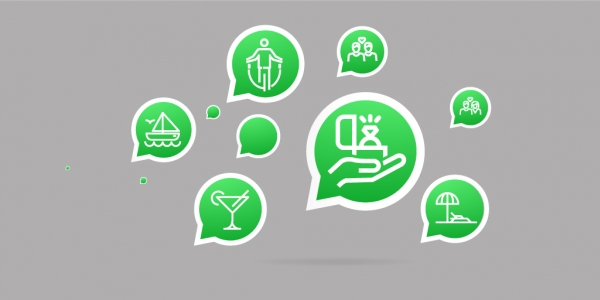WhatsApp wades in: Do we really need yet another Social Stories feature?

Today (February 24th) marks eight years to the day that WhatsApp was introduced to the world. Starting off as an app to merely let your friends know what you were up to, it has since gone on to introduce instant and group messaging, photo and video-sharing, and even most recently, video calling to rival the likes of Skype and FaceTime. In just eight years, WhatsApp has grown exponentially, and now sees 1.2 BILLION monthly active users. And the instant messaging app shows no signs of slowing down any time soon.
So earlier this week I opened WhatsApp to begin a conversation with a new contact and for a brief period found myself at a complete loss as to how do so. Gone was the usual “Favourites” tab containing all your phone contacts who were WhatsApp users and, in its place, a tab titled “Status”. Upon tapping this, I was scratching my head trying to figure out what on earth this was and what exactly WhatsApp had done with my contacts list…
…Many of you, like myself then, will have no doubt noticed this week that WhatsApp has introduced a new Stories-type feature, similar to that found on Snapchat and Instagram.
…Oh, and if you were wondering, you can start a new conversation with someone by going to the Chats tab and clicking the pen and paper-like icon in the top right-hand corner, then select the contact you wish to start a chat with… You’re welcome.
Called WhatsApp Status, it is a reinvention of the old Status tab; which merely allowed you to update a text-based status. The tab now enables you to share photos and videos, as well as GIFs, overlaid with drawings, emojis or captions with your contacts via your Status, which disappear after 24 hours (sound familiar?)
Since its roll-out earlier this week, users have been quick to take to Social Media to point out the stark similarities between WhatsApp Status and Instagram/Snapchat Stories. Many also took to Social to lament the loss of the beloved text-based statuses – no longer can we convey our emotions through heartfelt song lyrics, tv/movie quotes or a straight-up passive aggressive, indirect jab at someone we are not OK with right now. In all fairness, it is much harder to convey this in an image or video status, so I for one empathise with the lamenters of the loss of the text status.
Other naysayers deemed the update “unnecessary” and some even went as far as saying they hated it. An arguably lesser problem brought to light by users is that, as statuses do not last for longer than 24 hours, if someone was on holiday for example; they would have to update their Status every day to remind people they are away and should not be called. A trivial drawback, granted, but one to add to the list all the same.
But do we really need yet another Stories-type tool? We already have Snapchat and Instagram for this, after all. I do see why the powers that be (looking at you, Zuckerberg) may have seen the huge potential it could have – after all, Instagram stories has reportedly “stolen” users from Snapchat; with a 20-30% decline in Snapchat Stories viewership since August 2016 (when Instagram Stories first rolled out), not to mention the fact that in just 5 months since its rollout, Instagram Stories has reached 150 million daily users, a feat that took Snapchat until around June 2016 (almost 5 years after its launch) to achieve. – however, it does feel like the Facebook guys have lost sight of WhatsApp’s core purpose; to allow users to keep in touch with their friends and family (something I will come onto later). Aside from setting a profile picture and the ability to share photos/videos within messages, it is not a picture-based app unlike Snapchat and Instagram; whose core offering revolves around the sending/uploading of images and videos.
Unlike Snapchat and Instagram, many users have family members on WhatsApp and actively keep in touch with them on the app. As such, many users have voiced their concerns about posting these new Statuses when it will be there for their parents to see, for example. This could arguably detract people from using the feature and is therefore a potential sticking point for WhatsApp Status.
Moreover, WhatsApp is inherently an active app. To use it, you have to be actively engaged in chats with contacts, otherwise there is not much point in going on the app. This may change over time as people warm/get used to WhatsApp Status but certainly, at first, it may cause a somewhat sluggish adoption rate.
Maybe though, the success of WhatsApp Status will come from adoption by brands advertising via the feature. Some brands have already started to use WhatsApp for marketing purposes, so it could be seen to be a natural progression for these brands; diversifying the way they market to their audiences and opening a whole raft of new opportunities for advertising. I’m sure WhatsApp won’t be able to resist the opportunity to monetise Status and there has been word that they could start showing ads between users’ statuses, as is seen on Instagram and Snapchat. Branded filters for use on statuses is another potential avenue for WhatsApp and brands alike to consider.
Ultimately though, even if WhatsApp Status was to fail, its 1.2bn monthly users and 60bn messages sent each day tells me they won’t lose much sleep over it, and would likely just chalk it up to experience. Nonetheless, it will be very interesting to see over the coming months how WhatsApp competes with incumbent stalwarts Instagram and Snapchat in the “Stories” arena and whether 3 is indeed a crowd…
